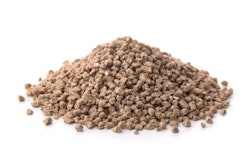
Rabobank report says the country’s hog feed consumption will bottom out in the first half of 2020, while poultry feed consumption will grow
China’s total animal feed demand will rebound by 8% in 2020, according to a report from Rabobank.
The latest global update on African swine fever (ASF) from Rabobank says China’s hog feed consumption will likely bottom out in the first half of 2020, while poultry feed consumption will continue to grow. China’s hog feed is expected to rebound by 5% year over year in 2020. In a previous report, Rabobank said hog feed consumption will fall by 40% in 2019.
Due to increased poultry consumption as a substitute for pork, Rabobank said consumption of poultry feed and other feed will see even higher growth rates in 2020.
Soybean meal and feed corn usage
Soybean meal usage is estimated to decline by 6% in 2019, despite a 17% drop in total feed demand, based on a higher inclusion ratio.
The outcome of trade talks between the U.S. and China will affect soybean meal and feed corn usage. If a trade deal is reached, China’s soybean meal usage could rebound, while feed corn will be partially substituted by imported U.S. sorghum and dried distillers grains with solubles (DDGS). If the two countries do not reach a trade deal, Chinese feed mills could continue using local feed corn in feed rations, cutting soybean meal use.
If the inclusion ratio remains high in 2020, China’s soybean meal usage could rebound by 8%, but if the inclusion ratio returns to low levels, another year of decline is likely.
Pig herd loss, meat output drop
Rabobank said China’s pig herd loss is expected to be 55% in 2019, with the sow herd seeing a larger decline.
“The scale of the decline in China in 2019 is unprecedented, and it will lead to even lower production in 2020,” the report said.
Further declines are expected in the first half of 2020, with restocking likely in the second half. The pace of herd loss will slow in 2020 due to reduced farm numbers and increased biosecurity. The best-case scenario, the report said, is that the herd will be slightly larger at the end of 2020 than at the beginning, by 8%.
The number of hogs available for slaughter is expected to decline greatly in 2020, and China’s pork meat supply is expected to fall by 15% in 2020, compared with 2019.
Situation in Vietnam, Philippines
In the best-case scenario, Rabobank said Vietnam’s and the Philippines’ hog feed consumption will decrease by 7.9% and 8.4%, respectively, in 2020.
As a result of protein substitution in these countries, total consumption growth of poultry and aquafeed in Vietnam and the Philippines will be 5.4% and 2.1%, respectively, in 2020. Overall, total animal feed consumption in Vietnam and the Philippines will decrease by 2.1% and 4.3%, respectively, in 2020.
Vietnam’s corn and soybean meal demand is expected to decrease by 3.4% and 1.9%, respectively, in 2020. Corn and soybean meal demand for animal feed in the Philippines is expected to decrease by 4% and 3.9%, respectively, in 2020.
Vietnam’s imports of corn and soybean meal for animal feed are expected to decrease by 4.7% and 5.1%, respectively, in 2020. Imports of soybeans for animal feed production, however, are expected to increase by 6.1%, due to increasing demand from additional soybean crushing capacity. The Philippines’ imports of soybean meal for animal feed are expected to decrease by 3.2% in 2020.
View our continuing coverage of the African swine fever outbreak.

















